Forestry Research in the Middle East: A Bibliometric Analysis
Abstract
1. Introduction
- (1)
- What are the main scopes of forestry research in Iran, Israel, and Turkey?
- (2)
- How was the trend of forestry documents publication during the period 2005–2019?
- (3)
- How do these countries collaborate with other countries?
- (4)
- How many citations do these countries receive per document?
- (5)
- Which researchers and institutions had the most influence on the progress of forestry research in their country?
2. Materials and Methods
2.1. Forests of the Middle East
2.2. Analysis Procedure
2.2.1. Data
2.2.2. Methods
3. Results and Discussion
4. Conclusions
Author Contributions
Funding
Institutional Review Board Statement
Informed Consent Statement
Data Availability Statement
Conflicts of Interest
References
- Betts, R.; Cox, P.; Collins, M.; Harris, P.; Huntingford, C.; Jones, C. The role of ecosystem-atmosphere interactions in simulatronian precipitation decrease and forest dieback under global climate warming. Theor. Appl. Climatol. 2004, 78, 157–175. [Google Scholar] [CrossRef]
- Chen, Z.; Yu, G.; Wang, Q. Effects of climate and forest age on the ecosystem carbon exchange of afforestation. J. For. Res. 2020, 31, 365–374. [Google Scholar] [CrossRef]
- Bremer, L.L.; Farley, K.A. Does plantation forestry restore biodiversity or create green deserts? A synthesis of the effects of land-use transitions on plant species richness. Biodivers. Conserv. 2010, 19, 3893–3915. [Google Scholar] [CrossRef]
- Stephens, S.S.; Wagner, M.R. Forest plantations and biodiversity: A fresh perspective. J. For. 2007, 105, 307–313. [Google Scholar]
- Mishra, S.; Hättenschwiler, S.; Yang, X. The plant microbiome: A missing link for the understanding of community dynamics and multifunctionality in forest ecosystems. Appl. Soil Ecol. 2020, 145, 103345. [Google Scholar] [CrossRef]
- Lafforgue, G.; Magné, B.; Moreaux, M. Energy substitutions, climate change and carbon sinks. Ecol. Econ. 2008, 67, 589–597. [Google Scholar] [CrossRef]
- Amin, M.; Zhang, J.; Yang, M. Effects of climate change on the yield and cropping area of major food crops: A case of Bangladesh. Sustainability 2015, 7, 898–915. [Google Scholar] [CrossRef]
- Hisano, M.; Searle, E.B.; Chen, H.Y. Biodiversity as a solution to mitigate climate change impacts on the functioning of forest ecosystems. Biol. Rev. 2018, 93, 439–456. [Google Scholar] [CrossRef]
- Natale, F.; Fiore, G.; Hofherr, J. Mapping the research on aquaculture. A bibliometric analysis of aquaculture literature. Scientometrics 2012, 90, 983–999. [Google Scholar] [CrossRef]
- Maurya, S.K.; Shukla, A.; Ngurtinkhuma, R. OPEC countries: Research performance across nations in Library and Information Science. Int. J. Inf. Sci. Manag. 2018, 16, 101–110. [Google Scholar]
- Cameron, B.D. Trends in the usage of ISI bibliometric data: Uses, abuses, and implications. Portal Libr. Acad. 2005, 5, 105–125. [Google Scholar] [CrossRef]
- Falagas, M.E.; Papastamataki, P.A.; Bliziotis, I.A. A bibliometric analysis of research productivity in Parasitology by different world regions during a 9-year period (1995–2003). BMC Infect. Dis. 2006, 6, 56. [Google Scholar] [CrossRef] [PubMed]
- Chirici, G. Assessing the scientific productivity of Italian forest researchers using the Web of Science, SCOPUS and SCIMAGO databases. Iforest Biogeosci. For. 2012, 5, 101. [Google Scholar] [CrossRef]
- Li, W.; Zhao, Y. Bibliometric analysis of global environmental assessment research in a 20-year period. Environ. Impact Assess. Rev. 2015, 50, 158–166. [Google Scholar] [CrossRef]
- Bouyssou, D.; Marchant, T. Consistent bibliometric rankings of authors and of journals. J. Informetr. 2010, 4, 365–378. [Google Scholar] [CrossRef][Green Version]
- Abramo, G.; D’Angelo, C.A. Assessing national strengths and weaknesses in research fields. J. Informetr. 2014, 8, 766–775. [Google Scholar] [CrossRef]
- Hood, W.W.; Wilson, C.S. The literature of bibliometrics, scientometrics, and informetrics. Scientometrics 2001, 52, 291–314. [Google Scholar] [CrossRef]
- Shapiro, F.R. Origins of bibliometrics, citation indexing, and citation analysis: The neglected legal literature. J. Am. Soc. Inf. Sci. 1992, 43, 337–339. [Google Scholar] [CrossRef]
- Pardey, P.G.; Christian, J.E. The Production and Diffusion of Policy Knowledge: A Bibliometric Evaluation of the International Food Policy Research Institute; Policy Research Institute (IFPRI): Washington, DC, USA, 2002. [Google Scholar]
- Bettinger, P.; Merry, K.; McNulty, S.; Siry, J.; Gavazzi, M. Variation in results of three biology-focused search engines: A case study using North American tree species. Bull. Ecol. Soc. Am. 2021, 102, e01808. [Google Scholar] [CrossRef]
- Laband, D.N.; Zhang, D. Citations, publications, and perceptions-based rankings of the research impact of North American forestry programs. J. For. 2006, 104, 254–261. [Google Scholar]
- Albert, M.B.; Avery, D.; Narin, F.; McAllister, P. Direct validation of citation counts as indicators of industrially important patents. Res. Policy 1991, 20, 251–259. [Google Scholar] [CrossRef]
- Martínez-Gómez, A. Bibliometrics as a tool to map uncharted territory: A study on non-professional interpreting. Perspectives 2015, 23, 205–222. [Google Scholar] [CrossRef]
- Gambella, F.; Sistu, L.; Piccirilli, D.; Corposanto, S.; Caria, M.; Arcangeletti, E.; Proto, A.R.; Chessa, G.; Pazzona, A. Forest and UAV: A bibliometric review. Contemp. Eng. Sci. 2016, 9, 1359–1370. [Google Scholar] [CrossRef]
- Pautasso, M. Scientometrics of forest health and tree diseases: An overview. Forests 2016, 7, 17. [Google Scholar] [CrossRef]
- Aleixandre-Benavent, R.; Aleixandre-Tudó, J.L.; Castelló-Cogollos, L.; Aleixandre, J.L. Trends in global research in deforestation. A bibliometric analysis. Land Use Policy 2018, 72, 293–302. [Google Scholar] [CrossRef]
- Aleixandre-Benavent, R.; Aleixandre-Tudó, J.L.; Castelló-Cogollos, L.; Aleixandre, J.L. Trends in scientific research on climate change in agriculture and forestry subject areas (2005–2014). J. Clean. Prod. 2017, 147, 406–418. [Google Scholar] [CrossRef]
- Aznar-Sánchez, J.A.; Belmonte-Ureña, L.J.; López-Serrano, M.J.; Velasco-Muñoz, J.F. Forest ecosystem services: An analysis of worldwide research. Forests 2018, 9, 453. [Google Scholar] [CrossRef]
- Song, Y.; Zhao, T. A bibliometric analysis of global forest ecology research during 2002–2011. SpringerPlus 2013, 2, 204. [Google Scholar] [CrossRef]
- Bullock, R.; Lawler, J. Community forestry research in Canada: A bibliometric perspective. For. Policy Econ. 2015, 59, 47–55. [Google Scholar] [CrossRef]
- Giannetti, F.; Chirici, G.; Paoletti, E.; Borghetti, M.; Corona, P.; Bucci, G. Assessing the bibliometric productivity of forest scientists in Italy. Ann. Silvic. Res. 2016, 40, 19–30. [Google Scholar]
- Vanclay, J.K. Ranking forestry journals using the h-index. J. Informetr. 2008, 2, 326–334. [Google Scholar] [CrossRef][Green Version]
- Malesios, C.; Arabatzis, G. An evaluation of forestry journals using bibliometric indices. Ann. For. Res. 2012, 55, 147–164. [Google Scholar]
- Kelsey, P.; Diamond, T. Establishing a core list of journals for forestry: A citation analysis from faculty at southern universities. Coll. Res. Libr. 2003, 64, 357–377. [Google Scholar] [CrossRef]
- Bojović, S.; Matić, R.; Popović, Z.; Smiljanić, M.; Stefanović, M.; Vidaković, V. An overview of forestry journals in the period 2006–2010 as basis for ascertaining research trends. Scientometrics 2014, 98, 1331–1346. [Google Scholar] [CrossRef]
- Uribe-Toril, J.; Ruiz-Real, J.L.; Haba-Osca, J.; de Pablo Valenciano, J. Forests’ first decade: A bibliometric analysis overview. Forests 2019, 10, 72. [Google Scholar] [CrossRef]
- Huang, L.; Zhou, M.; Lv, J.; Chen, K. Trends in global research in forest carbon sequestration: A bibliometric analysis. J. Clean. Prod. 2020, 252, 119908. [Google Scholar] [CrossRef]
- Fazeli-Varzaneh, M. An investigation of the literature of the Hyrcanian forests in Web of Science based on scientometric indicators. Iran. J. For. Poplar Res. 2020, 28, 97–109. [Google Scholar]
- Nikzad, M.; Jamali, H.R.; Hariri, N. Patterns of Iranian co-authorship networks in social sciences: A comparative study. Libr. Inf. Sci. Res. 2011, 33, 313–319. [Google Scholar] [CrossRef]
- Hirsch, J.E. An index to quantify an individual’s scientific research output. Proc. Natl. Acad. Sci. USA 2005, 102, 16569–16572. [Google Scholar] [CrossRef] [PubMed]
- Bihari, A.; Tripathi, S.; Deepak, A. A review on h-index and its alternative indices. J. Inf. Sci. 2021. [Google Scholar] [CrossRef]
- Glänzel, W. Science in Scandinavia: A bibliometric approach. Scientometrics 2000, 48, 121–150. [Google Scholar] [CrossRef]
- Frame, J.D. Mainstream research in Latin America and the Caribbean. Interciencia 1977, 2, 143–148. [Google Scholar]
- Schubert, A.; Braun, T. Relative indicators and relational charts for comparative assessment of publication output and citation impact. Scientometrics 1986, 9, 281–291. [Google Scholar] [CrossRef]
- Schubert, A.; Glänzel, W.; Braun, T. Scientometric datafiles. A comprehensive set of indicators on 2649 journals and 96 countries in all major science fields and subfields 1981–1985. Scientometrics 1989, 16, 3–478. [Google Scholar] [CrossRef]
- Jain, A.; Garg, K.; Sharma, P.; Kumar, S. Impact of SERC’s funding on research in chemical sciences. Scientometrics 1998, 41, 357–370. [Google Scholar] [CrossRef]
- Sarkar, D. Lattice: Multivariate Data Visualization with R; Springer Science & Business Media: New York, NY, USA, 2008. [Google Scholar]
- Van Eck, N.J.; Waltman, L. Software survey: VOSviewer, a computer program for bibliometric mapping. Scientometrics 2010, 84, 523–538. [Google Scholar] [CrossRef] [PubMed]
- Wu, R.; Guo, F.; Wang, C.; Qian, B.; Shen, F.; Huang, F.; Xu, W. Bibliometric analysis of global circular RNA research trends from 2007 to 2018. Cell J. 2021, 23, 238–246. [Google Scholar]
- Allen, C.D.; Macalady, A.K.; Chenchouni, H.; Bachelet, D.; McDowell, N.; Vennetier, M.; Kitzberger, T.; Rigling, A.; Breshears, D.D.; Hogg, E.T. A global overview of drought and heat-induced tree mortality reveals emerging climate change risks for forests. For. Ecol. Manag. 2010, 259, 660–684. [Google Scholar] [CrossRef]
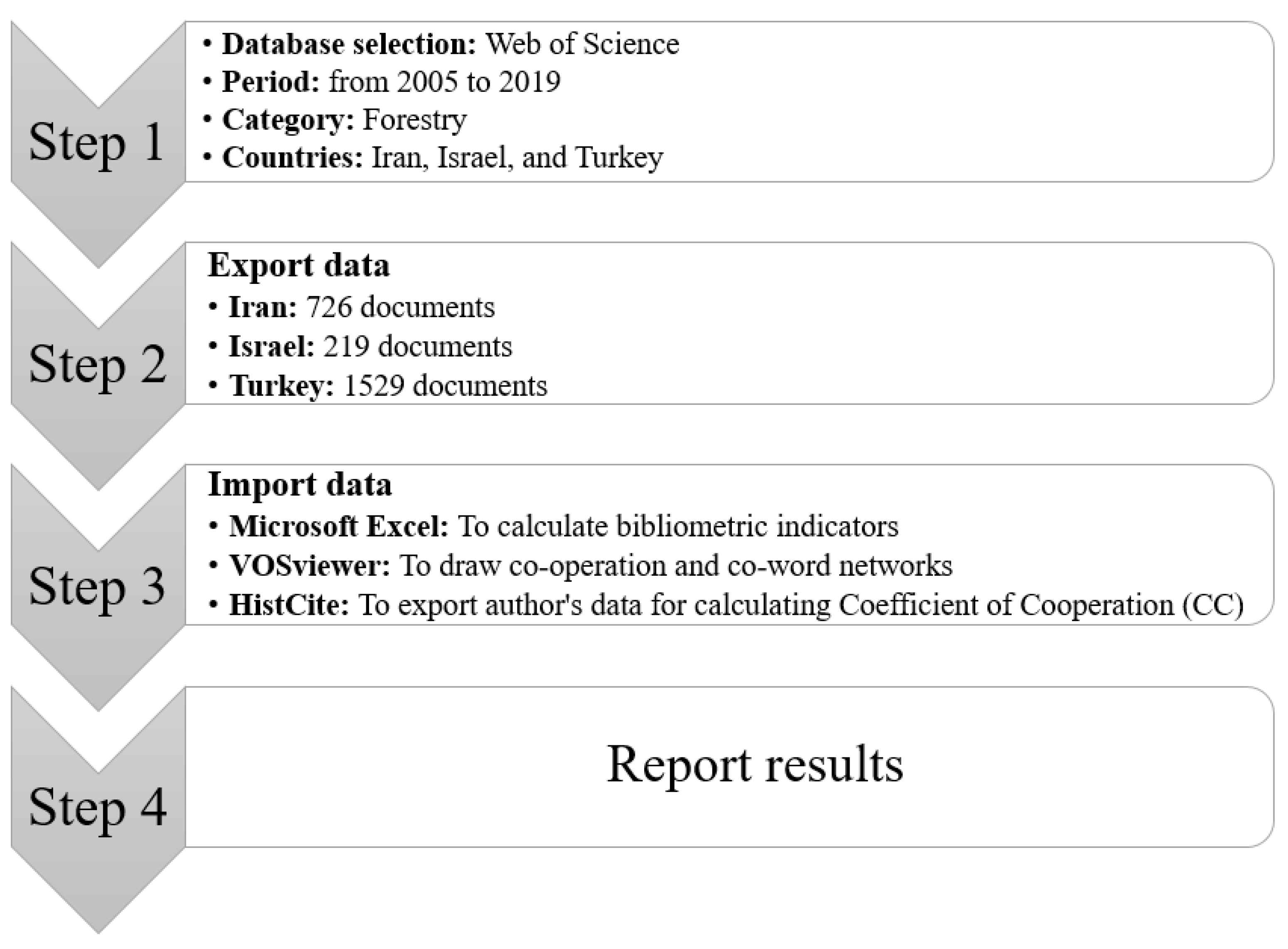
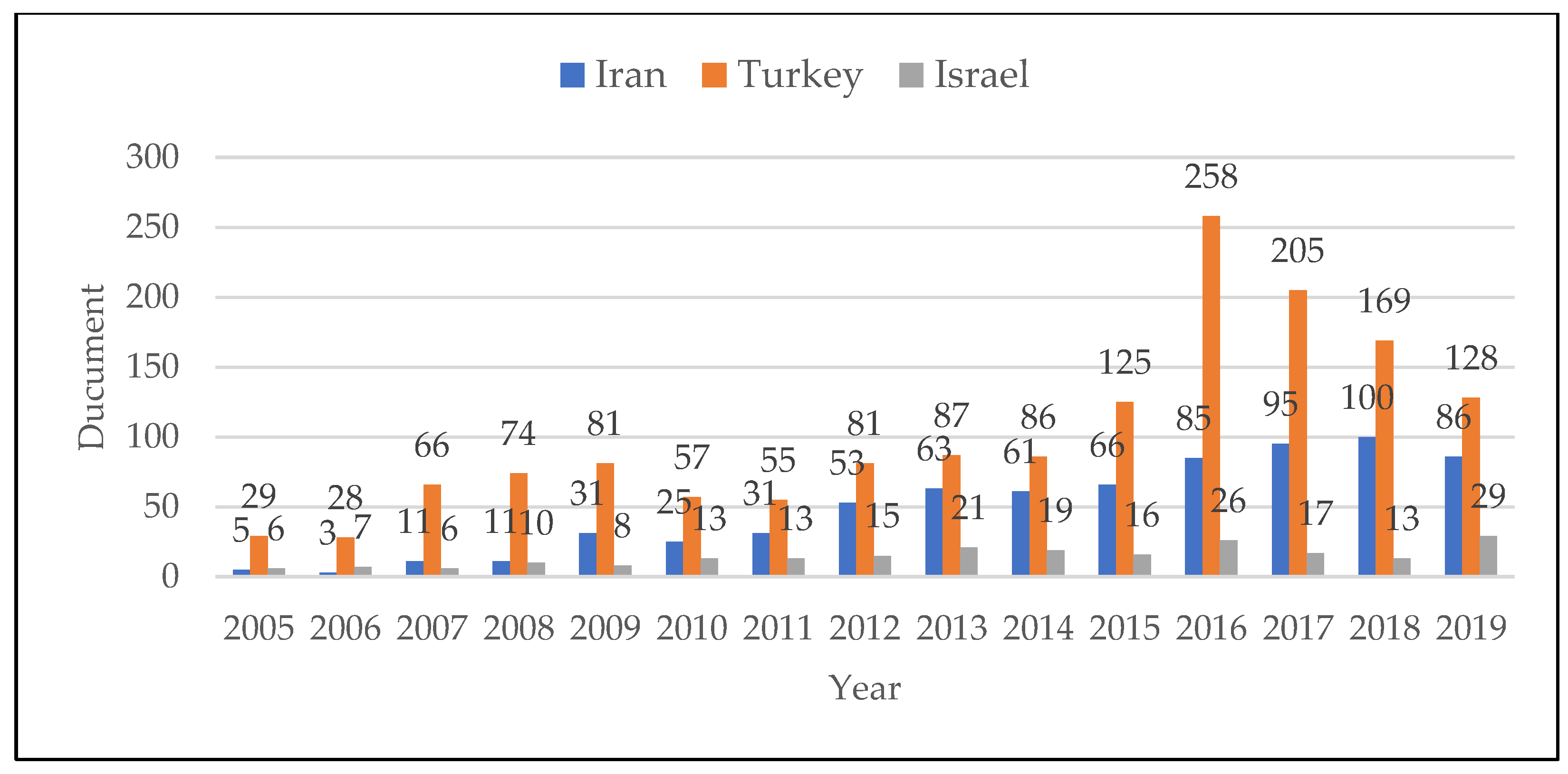
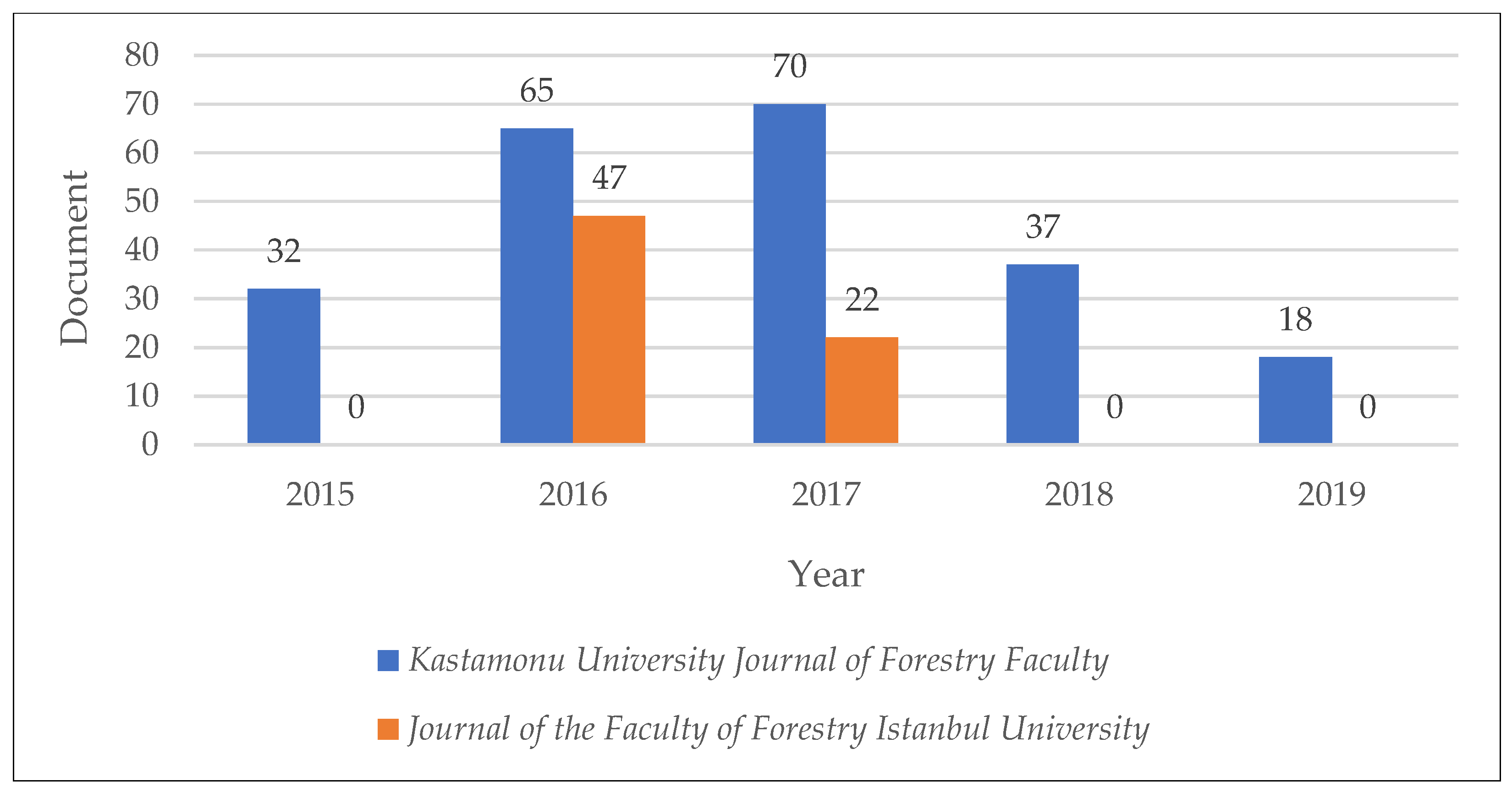
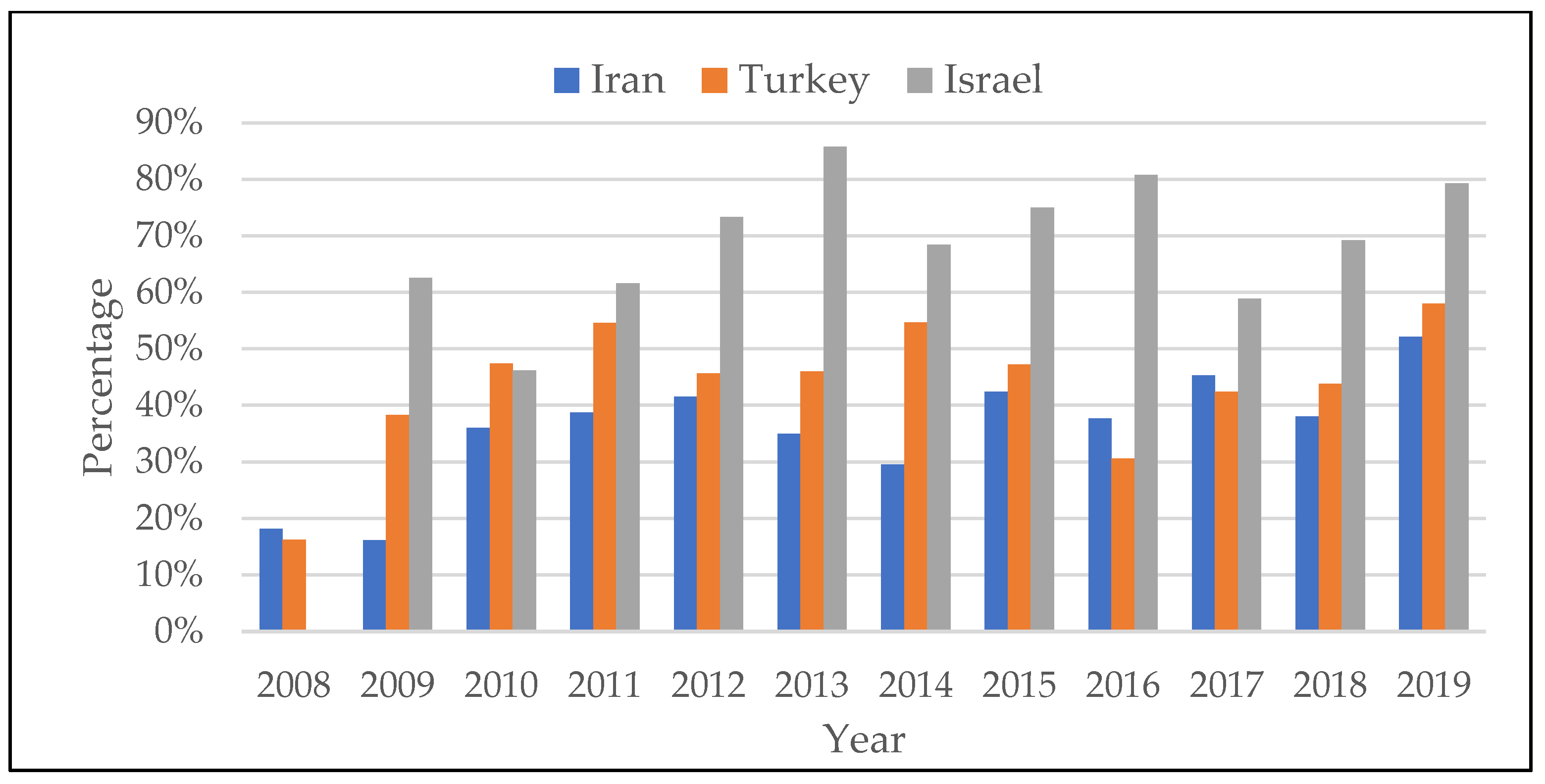
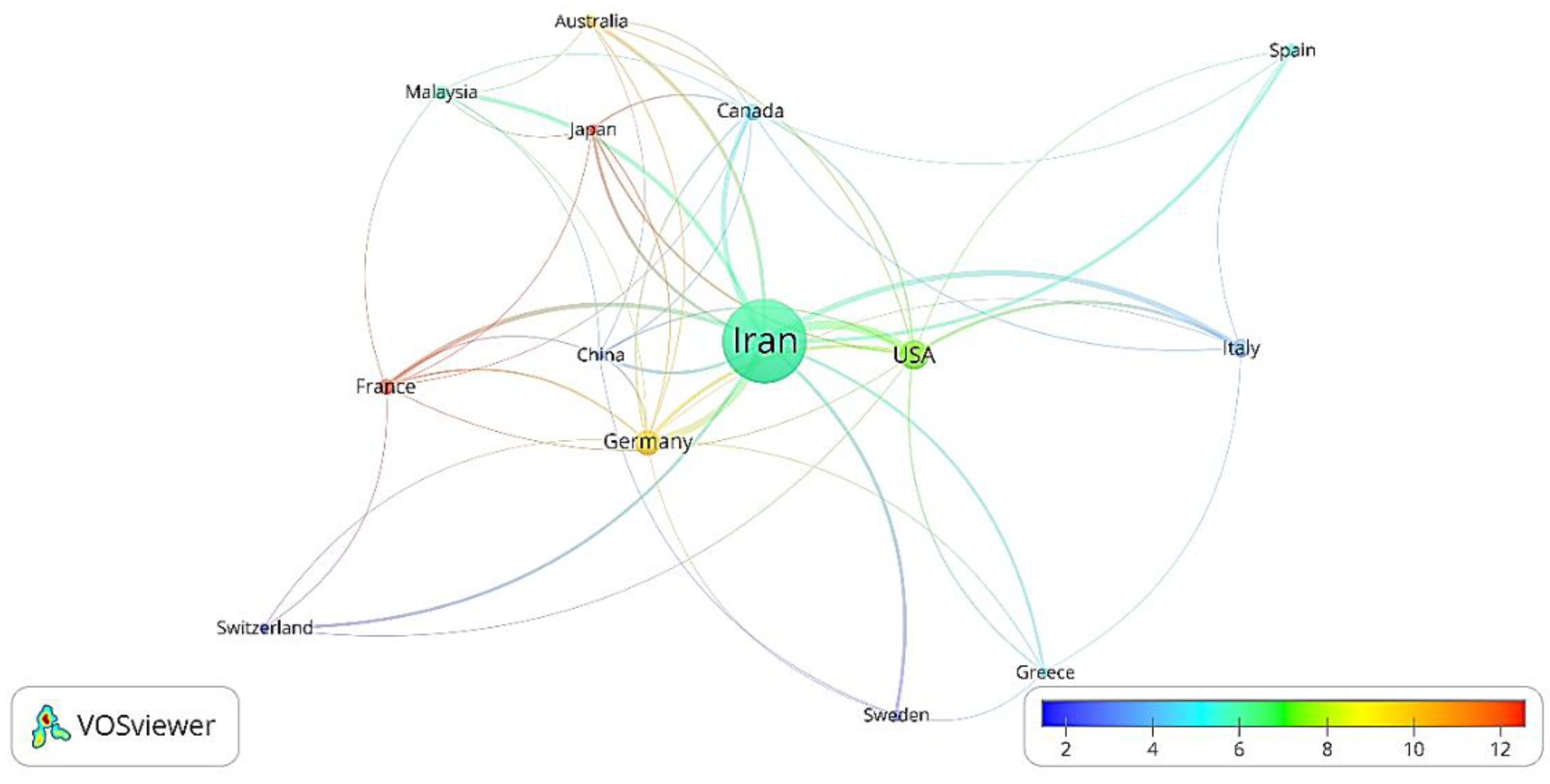


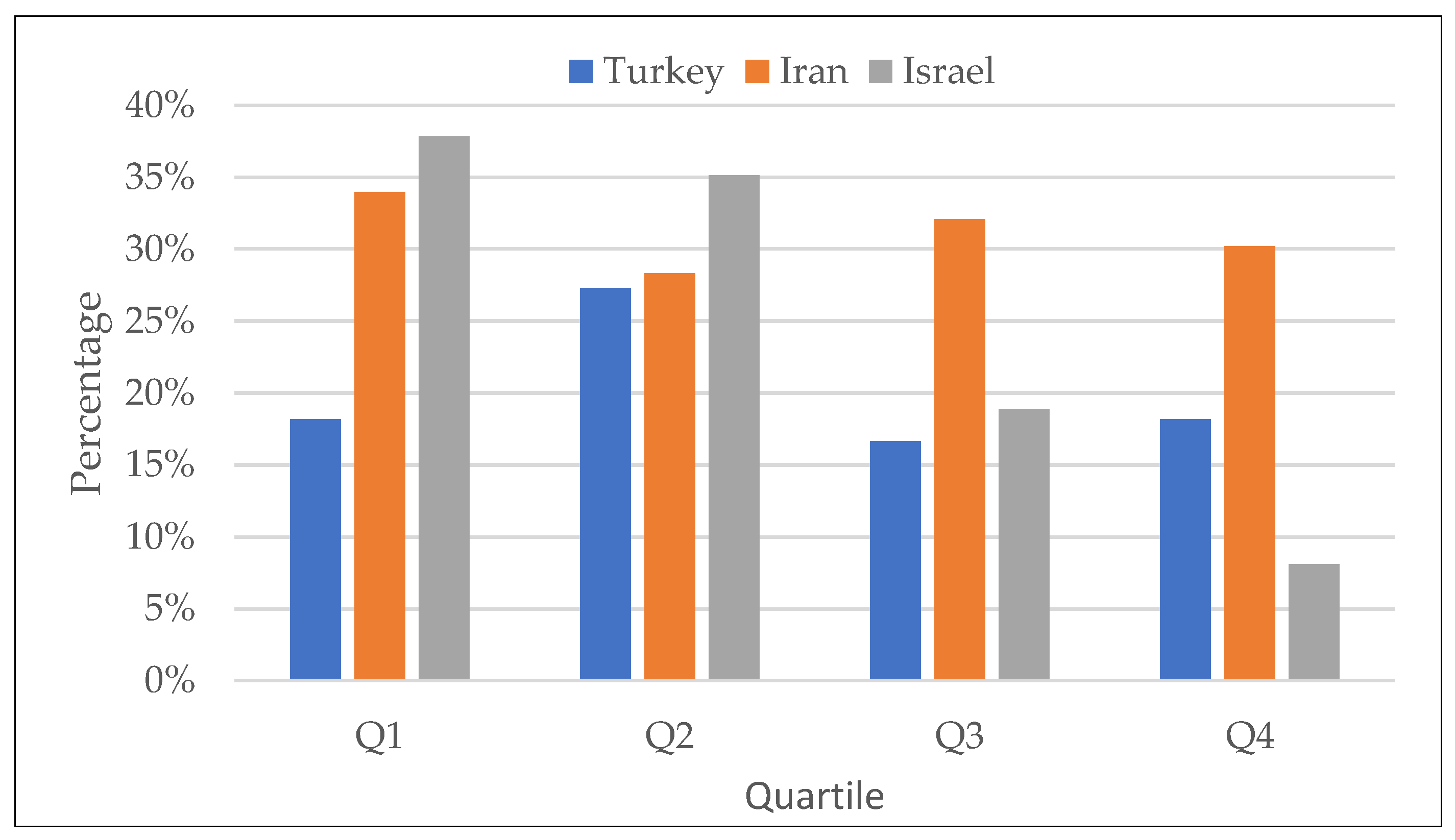


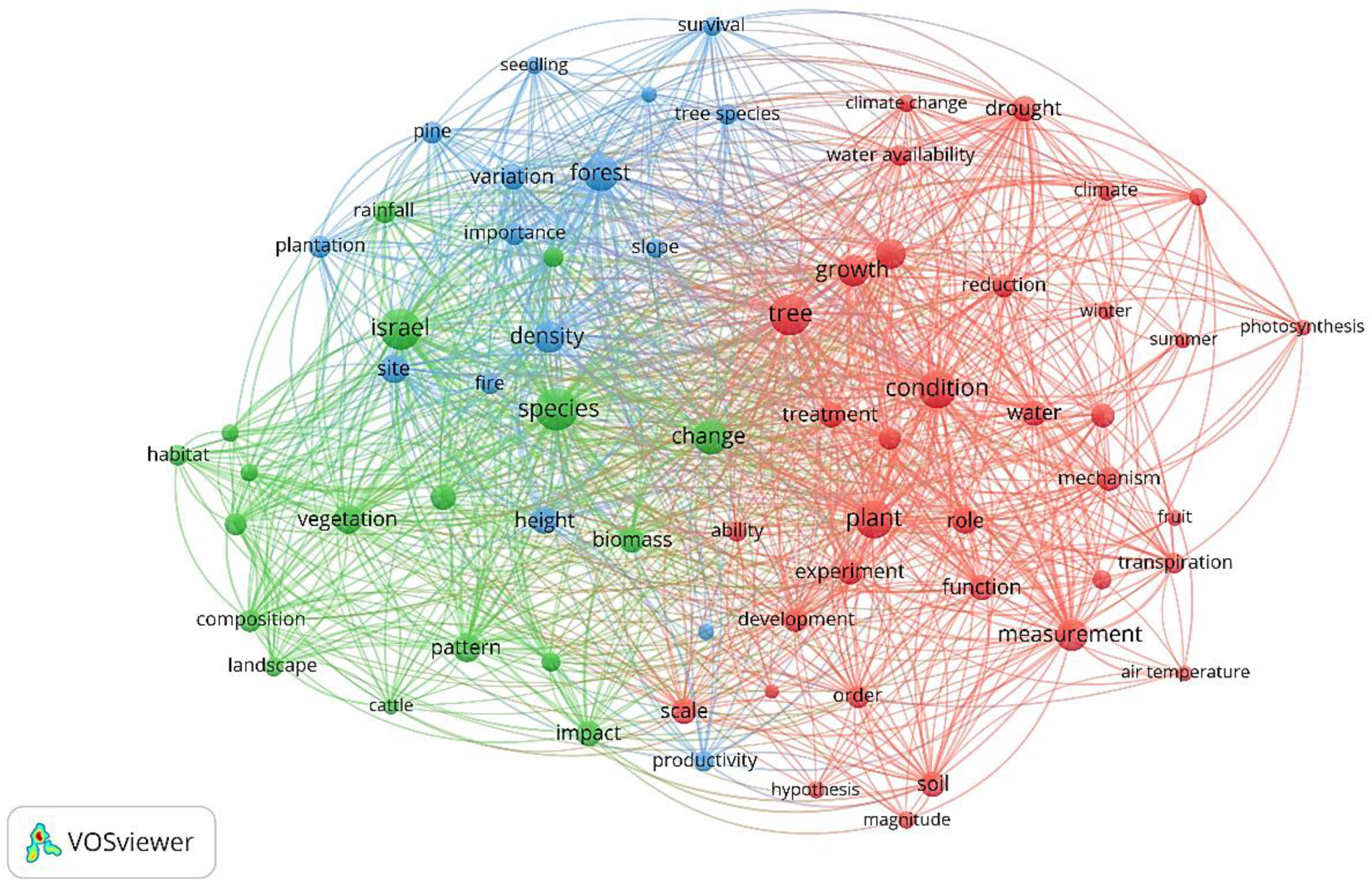
| Country | Total Land Area (1000 ha) | Forest Area (1000 ha) |
|---|---|---|
| Bahrain | 77 | 1 |
| Cyprus | 924 | 173 |
| Egypt | 99,545 | 45 |
| Iran | 162,876 | 10,752 |
| Iraq | 43,413 | 825 |
| Israel | 2164 | 140 |
| Jordan | 8878 | 98 |
| Kuwait | 1782 | 6 |
| Lebanon | 1023 | 143 |
| Oman | 30,950 | 3 |
| Palestine | 602 | 10 |
| Qatar | 1616 | 0 |
| Saudi Arabia | 214,969 | 977 |
| Syria | 18,363 | 522 |
| Turkey | 76,963 | 22,220 |
| United Arab Emirates | 7102 | 317 |
| Yemen | 52,797 | 549 |
| Index | Iran | Israel | Turkey |
|---|---|---|---|
| Number of documents | 726 | 219 | 1529 |
| Number of citations | 4433 | 3939 | 11,220 |
| Number of authors | 2828 | 1097 | 5625 |
| Citations per document | 6.11 | 17.99 | 7.34 |
| Documents per author | 0.256 | 0.199 | 0.271 |
| Citations per author | 1.56 | 3.59 | 1.99 |
| H-index | 23 | 34 | 31 |
| Relative specialization index (RSI) in forestry | −0.189 | −0.491 | 0.111 |
| Cooperation coefficient (CC) | 0.680 | 0.706 | 0.587 |
| Number of funding agencies | 274 | 234 | 375 |
| Total funds * | 870 | 353 | 881 |
| Documents received funding | 284 | 136 | 604 |
| Ratio of funded articles (%) | 38 | 62 | 39 |
| Country | Rank | Journal | Publisher Country | Language | No. of Articles | Share of Articles That Received Funding (%) | Journal’s Quartile (in the Forestry Category) | Impact Factor (2019) |
|---|---|---|---|---|---|---|---|---|
| Iran | 1 | Journal of Forestry Research | China | English | 93 | 42.1 | Q2 | 1.689 |
| 2 | Turkish Journal of Agriculture and Forestry | Turkey | English | 63 | 33.3 | Q2 | 1.660 | |
| 3 | European Journal of Wood and Wood Products | USA | English/German | 54 | 32.7 | Q3 | 1.542 | |
| 4 | Forest Pathology | USA | English | 31 | 55.9 | Q3 | 1.196 | |
| 5 | Trees Structure and Function | Germany | English | 31 | 61.3 | Q2 | 2.125 | |
| 6 | Croatian Journal of Forest Engineering | Croatia | English/Croatian | 27 | 33.3 | Q1 | 2.500 | |
| 7 | European Journal of Forest Research | USA | English | 25 | 44.0 | Q1 | 2.451 | |
| 8 | iforest | Italy | English | 24 | 34.6 | Q2 | 1.683 | |
| 9 | Forest Ecology and Management | Netherlands | English | 20 | 65.0 | Q1 | 3.170 | |
| 10 | Urban Forestry and Urban Greening | Germany | English | 20 | 25.0 | Q1 | 4.021 | |
| Israel | 1 | Agricultural and Forest Meteorology | Netherlands | English | 40 | 65 | Q1 | 4.651 |
| 2 | Tree Physiology | England | English | 26 | 69.24 | Q1 | 3.655 | |
| 3 | Forest Ecology and Management | Netherlands | English | 20 | 60 | Q1 | 3.170 | |
| 4 | Journal of Vegetation Science | USA | English | 16 | 43.75 | Q1 | 2.698 | |
| 5 | Plant Ecology | Netherlands | English | 15 | 73.34 | Q3 | 1.509 | |
| 6 | International Journal of Wildland Fire | Australia | English | 9 | 55.56 | Q1 | 2.627 | |
| 7 | Tree Genetics Genomes | Germany | English | 9 | 88.89 | Q2 | 2.081 | |
| 8 | Trees Structure and Function | Germany | English | 7 | 42.86 | Q2 | 2.125 | |
| 9 | Annals of Forest Science | France | English | 6 | 83.34 | Q2 | 2.033 | |
| 10 | Applied Vegetation Science | USA | English | 6 | 83.34 | Q1 | 2.574 | |
| Turkey | 1 | Turkish Journal of Agriculture and Forestry | Turkey | English | 534 | 49.8 | Q2 | 1.660 |
| 2 | Kastamonu University Journal of Forestry Faculty | Turkey | English/Turkish/Spanish | 222 | 17.7 | - * | - | |
| 3 | Journal of the Faculty of Forestry-Istanbul University | Turkey | English/Turkish | 69 | 11.6 | - | - | |
| 4 | Forest Products Journal | USA | English | 46 | 13.0 | Q4 | 0.802 | |
| 5 | Journal of Forestry Research | China | English | 37 | 57.9 | Q2 | 1.689 | |
| 6 | European Journal of Wood and Wood Products | USA | English/German | 36 | 33.3 | Q3 | 1.542 | |
| 7 | Sumarski List | Croatia | Different language | 35 | 43.2 | Q4 | 0.451 | |
| 8 | Forest Pathology | USA | Croatian/English | 34 | 67.6 | Q3 | 1.196 | |
| 9 | iforest | Italy | English | 29 | 51.7 | Q2 | 1.683 | |
| 10 | Forestist | Turkey | English | 27 | 51.9 | - | - |
| Country | Rank | Institute | No. of Documents | No. of Citations | CPD | Funded Articles (%) | RSI |
|---|---|---|---|---|---|---|---|
| Iran | 1 | University of Tehran | 204 | 1229 | 6.02 | 34.18 | 0.355 |
| 2 | Tarbiat Modares University | 112 | 834 | 7.45 | 35.90 | 0.379 | |
| 3 | Islamic Azad University | 105 | 590 | 5.62 | 32.11 | −0.270 | |
| 4 | University of Guilan | 73 | 265 | 3.63 | 29.73 | 0.640 | |
| 5 | Shahid Rajaee Teacher Training University | 40 | 386 | 9.65 | 43.91 | 0.791 | |
| 6 | Gorgan University of Agricultural Sciences and Natural Resources | 31 | 131 | 4.23 | 36.37 | 0.792 | |
| 7 | Sari Agricultural Sciences Natural Resources University | 27 | 97 | 3.59 | 37.94 | 0.864 | |
| 8 | University of Tabriz | 27 | 167 | 6.19 | 25.93 | −0.025 | |
| 9 | University of Kurdistan | 23 | 99 | 4.3 | 47.83 | 0.550 | |
| 10 | University of Mohaghegh Ardabili | 23 | 49 | 2.13 | 21.74 | 0.536 | |
| Israel | 1 | Volcani Institute of Agricultural Research | 77 | 1493 | 19.39 | 70.13 | 0.765 |
| 2 | Ben Gurion University | 61 | 994 | 16.29 | 67.22 | −0.138 | |
| 3 | Hebrew University of Jerusalem | 53 | 905 | 17.07 | 60.38 | −0.401 | |
| 4 | University of Haifa | 36 | 444 | 12.33 | 58.34 | −0.023 | |
| 5 | Weizmann Institute of Science | 26 | 875 | 33.65 | 76.93 | −0.350 | |
| 6 | Tel Aviv University | 16 | 181 | 11.31 | 43.75 | −0.830 | |
| 7 | Technion Israel Institute of Technology | 13 | 344 | 26.46 | 61.54 | −0.756 | |
| 8 | Agricultural Research Organization | 12 | 144 | 12 | 83.34 | 0.127 | |
| 9 | Jewish National Fund | 7 | 76 | 10.85 | 85.72 | 0.993 | |
| 10 | Academic and Technology College of Tel-Hai | 7 | 39 | 5.57 | 57.15 | 0.465 | |
| Turkey | 1 | Istanbul University | 218 | 1287 | 5.9 | 38.47 | 0.465 |
| 2 | Karadeniz Teknik University | 174 | 921 | 5.29 | 30.56 | 0.761 | |
| 3 | Suleyman Demirel University | 121 | 817 | 6.75 | 45.91 | 0.709 | |
| 4 | Kastamonu University | 118 | 321 | 2.72 | 20.50 | 0.945 | |
| 5 | Cukurova University | 91 | 597 | 6.56 | 58.70 | 0.532 | |
| 6 | Duzce University | 89 | 425 | 4.78 | 42.23 | 0.821 | |
| 7 | Ministry of Food Agriculture Livestock Turkey | 86 | 510 | 5.93 | 54.03 | 0.828 | |
| 8 | Bartin University | 84 | 364 | 4.33 | 21.43 | 0.936 | |
| 9 | Kahramanmaras Sutcu Imam University | 74 | 431 | 5.82 | 36.12 | 0.775 | |
| 10 | Cankiri Karatekin University | 72 | 284 | 3.94 | 39.48 | 0.919 |
| Country | Rank | Author | No. of Documents | No. of Citations | CPD |
|---|---|---|---|---|---|
| Iran | 1 | Hamid Reza Taghiyari | 35 | 376 | 10.7 |
| 2 | Ramin Naghdi | 24 | 90 | 3.8 | |
| 3 | Mehrdad Nikooy | 21 | 72 | 3.4 | |
| 4 | Kambiz Pourtahmasi | 20 | 142 | 7.1 | |
| 5 | Ahmad Solgi | 17 | 75 | 4.4 | |
| 6 | Seyed Mohsen Hosseini | 16 | 78 | 4.9 | |
| 7 | Pedram Attarod | 14 | 117 | 8.4 | |
| 8 | Ghanbar Ebrahimi | 14 | 85 | 6.1 | |
| 9 | Soleiman Mohammadi Limaei | 14 | 49 | 3.5 | |
| 10 | Akbar Najafi | 14 | 146 | 10.4 | |
| Israel | 1 | Shabtai Cohen | 20 | 608 | 30.4 |
| 2 | Dan Yakir | 18 | 721 | 40.1 | |
| 3 | Yagil Osem | 17 | 217 | 12.8 | |
| 4 | Avi Perevolotsky | 14 | 224 | 16.0 | |
| 5 | Tamir Klein | 12 | 338 | 28.2 | |
| 6 | Yossi Moshe | 11 | 128 | 11.6 | |
| 7 | Eyal Rotenberg | 11 | 456 | 41.5 | |
| 8 | Nurit Agam | 10 | 337 | 33.7 | |
| 9 | Yohay Carmel | 8 | 257 | 32.1 | |
| 10 | Jaime Kigel | 8 | 145 | 18.1 | |
| Turkey | 1 | Nadir Ayrilmis | 28 | 371 | 13.3 |
| 2 | Abdullah E. Akay | 26 | 129 | 5.0 | |
| 3 | Ramazan Ozcelik | 26 | 218 | 8.4 | |
| 4 | Emin Zeki Baskent | 25 | 157 | 6.3 | |
| 5 | Yusuf Ziya Erdil | 19 | 129 | 6.8 | |
| 6 | Ender Makineci | 19 | 68 | 3.6 | |
| 7 | Asko Lehtijarvi | 17 | 88 | 5.2 | |
| 8 | Unal Akkemik | 16 | 61 | 3.8 | |
| 9 | Hatice T. Dogmus-Lehtijarvi | 16 | 177 | 11.1 | |
| 10 | Ali Kasal | 16 | 128 | 8.0 |
| Country | Clusters | Color | Total Keywords | Total Occurrence of Keywords | Keyword |
|---|---|---|---|---|---|
| Iran | 1 | Red | 33 | 2342 | Iran (270), species (204), tree (204), forest (192), characteristic (110), northern Iran (89), variation (77), stand (76), structure (74), distribution (69), variable (66), Hyrcanian forest (62), site (62), size (62), tree species (61), height (57), role (57), diversity (56), oak (46), importance (42), beech (40), oriental beech (38), Fagus orientalis Lipsky (36), accuracy (34), season (34), breast height (32), north (32), conservation (31), stem (29), Zagros forest (27), rainfall (25), Caspian forest (24), dbh (24) |
| 2 | Green | 22 | 1204 | wood (113), density (111), treatment (108), strength (77), temperature (75), increase (68), thickness (65), influence (63), water (58), weight (56), quality (55), specimen (48), water absorption (39), panel (37), decrease (36), resin (36), rupture (34), elasticity (29), physical property (27), reduction (27), g cm (21), moe (21) | |
| 3 | Blue | 19 | 867 | soil (104), change (100), impact (81), distance (59), slope (54), operation (52), combination (50), depth (50), cost (40), bulk density (35), damage (34), trail (33), road (32), ground (31), extent (23), skidder (23), soil sample (23), soil compaction (22), soil disturbance (21) | |
| 4 | Yellow | 13 | 727 | condition (135), growth (82), order (74), plant (68), concentration (61), seedling (48), root (45), experiment (43), interaction (40), leaf (37), seed (35), medium (32), ability (27) | |
| Turkey | 1 | Red | 32 | 3357 | species (362), condition (305), characteristic (197), plant (173), quality (167), yield (165), concentration (143), soil (131), variation (130), cultivar (122), experiment (120), diversity (101), seed (97), genotype (88), season (80), combination (78), variety (76), selection (70), trait (70), root (67), black sea region (61), leaf (59), seedling (58), Europe (55), disease (54), interaction (54), marker (53), wheat (52), fruit (47), identification (43), isolate (41), family (38) |
| 2 | Green | 29 | 3450 | Turkey (671), forest (283), production (204), change (195), development (167), order (161), activity (157), structure (157), management (138), impact (116), approach (110), distribution (108), environment (93), product (83), forestry (75), problem (73), solution (73), importance (69), map (64), forest ecosystem (58), aspect (54), productivity (54), survey (49), fire (48), basis (42), Istanbul (41), forest area (40), recent year (34), regard (33) | |
| 3 | Blue | 27 | 2360 | treatment (212), wood (185), test (146), temperature (145), increase (143), density (140), loss (114), performance (114), water (107), strength (94), size (92), resistance (84), influence (82), specimen (79), measurement (78), decrease (74), reduction (55), scots pine (55), thickness (52), panel (49), Pinus sylvestris (47), laboratory (39), mdf (39), elasticity (35), oriental beech (35), medium density fiberboard (34), Fagus orientalis Lipsky (31) | |
| 4 | Yellow | 10 | 1063 | tree (267), growth (152), stand (121), site (119), height (118), tree species (76), age (73), Pinus brutia (57), ability (44), breast height (36) | |
| Israel | 1 | Red | 35 | 886 | tree (73), condition (60), plant (59), growth (41), measurement (41), season (39), role (32), experiment (29), drought (28), scale (27), water (27), function (26), soil (26), treatment (26), development (25), mechanism (25), temperature (24), increase (22), order (22), reduction (22), transpiration (19), water availability (19), ability (18), climate (16), leaf (16), climate change (14), magnitude (14), stomatal conductance (14), winter (14), hypothesis (13), fruit (12), air temperature (11), photosynthesis (11), summer (11), northern Israel (10) |
| 2 | Green | 18 | 519 | species (78), Israel (73), change (53), pattern (33), vegetation (33), biomass (28), impact (26), interaction (26), species richness (21), composition (20), rainfall (20), habitat (19), Mediterranean (18), landscape (17), environmental condition (15), species composition (14), shrub (13), cattle (12) | |
| 3 | Blue | 16 | 384 | forest (55), density (44), site (35), height (31), variation (28), pine (22), importance (21), plantation (21), productivity (19), fire (18), tree species (18), slope (17), survival (17), seedling (14), establishment (12), influence (12) |
Publisher’s Note: MDPI stays neutral with regard to jurisdictional claims in published maps and institutional affiliations. |
© 2021 by the authors. Licensee MDPI, Basel, Switzerland. This article is an open access article distributed under the terms and conditions of the Creative Commons Attribution (CC BY) license (https://creativecommons.org/licenses/by/4.0/).
Share and Cite
Fazeli-Varzaneh, M.; Bettinger, P.; Ghaderi-Azad, E.; Kozak, M.; Mafi-Gholami, D.; Jaafari, A. Forestry Research in the Middle East: A Bibliometric Analysis. Sustainability 2021, 13, 8261. https://doi.org/10.3390/su13158261
Fazeli-Varzaneh M, Bettinger P, Ghaderi-Azad E, Kozak M, Mafi-Gholami D, Jaafari A. Forestry Research in the Middle East: A Bibliometric Analysis. Sustainability. 2021; 13(15):8261. https://doi.org/10.3390/su13158261
Chicago/Turabian StyleFazeli-Varzaneh, Mohsen, Pete Bettinger, Erfan Ghaderi-Azad, Marcin Kozak, Davood Mafi-Gholami, and Abolfazl Jaafari. 2021. "Forestry Research in the Middle East: A Bibliometric Analysis" Sustainability 13, no. 15: 8261. https://doi.org/10.3390/su13158261
APA StyleFazeli-Varzaneh, M., Bettinger, P., Ghaderi-Azad, E., Kozak, M., Mafi-Gholami, D., & Jaafari, A. (2021). Forestry Research in the Middle East: A Bibliometric Analysis. Sustainability, 13(15), 8261. https://doi.org/10.3390/su13158261








